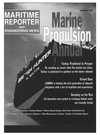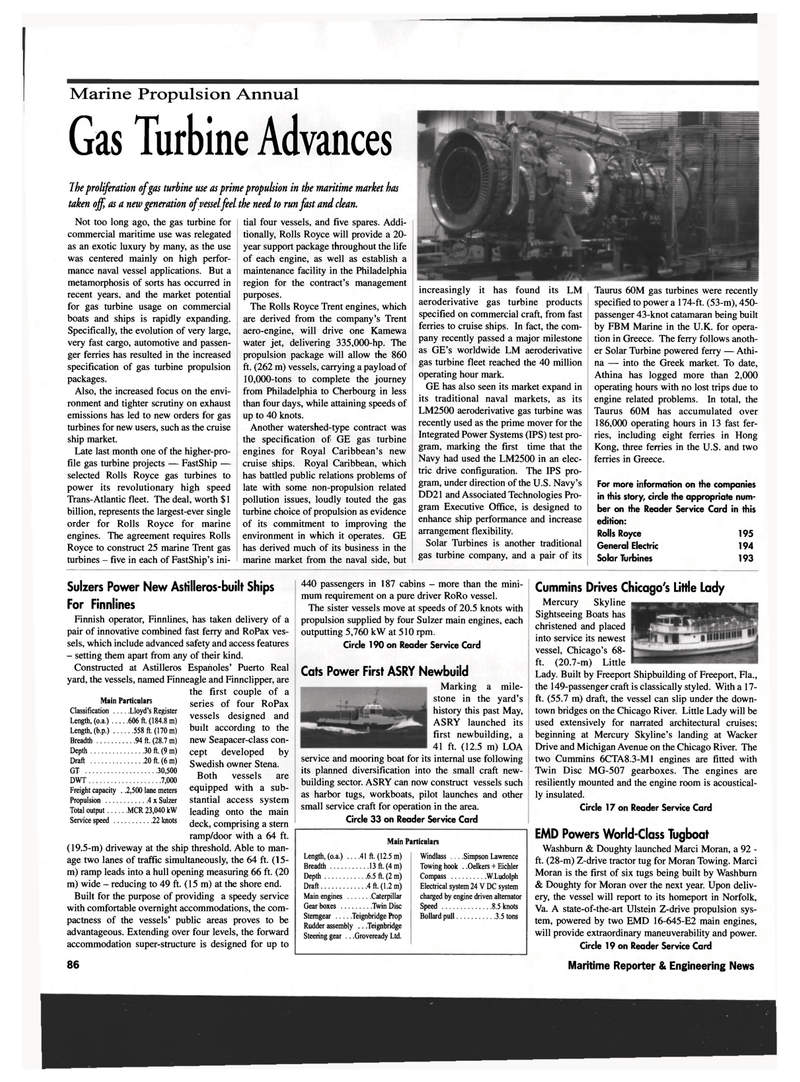
Page 88: of Maritime Reporter Magazine (September 1999)
Read this page in Pdf, Flash or Html5 edition of September 1999 Maritime Reporter Magazine
Marine Propulsion Annual
Gas Turbine Advances
The proliferation of gas turbine use as prime propulsion in the maritime market has taken off, as a new generation of vessel feel the need to run fast and clean.
Not too long ago, the gas turbine for commercial maritime use was relegated as an exotic luxury by many, as the use was centered mainly on high perfor- mance naval vessel applications. But a metamorphosis of sorts has occurred in recent years, and the market potential for gas turbine usage on commercial boats and ships is rapidly expanding.
Specifically, the evolution of very large, very fast cargo, automotive and passen- ger ferries has resulted in the increased specification of gas turbine propulsion packages.
Also, the increased focus on the envi- ronment and tighter scrutiny on exhaust emissions has led to new orders for gas turbines for new users, such as the cruise ship market.
Late last month one of the higher-pro- file gas turbine projects — FastShip — selected Rolls Royce gas turbines to power its revolutionary high speed
Trans-Atlantic fleet. The deal, worth $1 billion, represents the largest-ever single order for Rolls Royce for marine engines. The agreement requires Rolls
Royce to construct 25 marine Trent gas turbines - five in each of FastShip's ini- tial four vessels, and five spares. Addi- tionally, Rolls Royce will provide a 20- year support package throughout the life of each engine, as well as establish a maintenance facility in the Philadelphia region for the contract's management purposes.
The Rolls Royce Trent engines, which are derived from the company's Trent aero-engine, will drive one Kamewa water jet, delivering 335,000-hp. The propulsion package will allow the 860 ft. (262 m) vessels, carrying a payload of 10,000-tons to complete the journey from Philadelphia to Cherbourg in less than four days, while attaining speeds of up to 40 knots.
Another watershed-type contract was the specification of GE gas turbine engines for Royal Caribbean's new cruise ships. Royal Caribbean, which has battled public relations problems of late with some non-propulsion related pollution issues, loudly touted the gas turbine choice of propulsion as evidence of its commitment to improving the environment in which it operates. GE has derived much of its business in the marine market from the naval side, but increasingly it has found its LM aeroderivative gas turbine products specified on commercial craft, from fast ferries to cruise ships. In fact, the com- pany recently passed a major milestone as GE's worldwide LM aeroderivative gas turbine fleet reached the 40 million operating hour mark.
GE has also seen its market expand in its traditional naval markets, as its
LM2500 aeroderivative gas turbine was recently used as the prime mover for the
Integrated Power Systems (IPS) test pro- gram, marking the first time that the
Navy had used the LM2500 in an elec- tric drive configuration. The IPS pro- gram, under direction of the U.S. Navy's
DD21 and Associated Technologies Pro- gram Executive Office, is designed to enhance ship performance and increase arrangement flexibility.
Solar Turbines is another traditional gas turbine company, and a pair of its
Taurus 60M gas turbines were recently specified to power a 174-ft. (53-m), 450- passenger 43-knot catamaran being built by FBM Marine in the U.K. for opera- tion in Greece. The ferry follows anoth- er Solar Turbine powered ferry — Athi- na — into the Greek market. To date,
Athina has logged more than 2,000 operating hours with no lost trips due to engine related problems. In total, the
Taurus 60M has accumulated over 186,000 operating hours in 13 fast fer- ries, including eight ferries in Hong
Kong, three ferries in the U.S. and two ferries in Greece.
For more information on the companies in this story, circle the appropriate num- ber on the Reader Service Card in this edition:
Rolls Royce 195
General Electric 194
Solar Turbines 193
Sulzers Power New Astilleros-built Ships
For Finnlines
Finnish operator, Finnlines, has taken delivery of a pair of innovative combined fast ferry and RoPax ves- sels, which include advanced safety and access features - setting them apart from any of their kind.
Constructed at Astilleros Espanoles' Puerto Real yard, the vessels, named Finneagle and Finnclipper, are the first couple of a
Main Particulars series of four Ropax
Classification Lloyd's Register , , . , ,
Length, (o.a.) 606 ft. (184 8 m) vessels designed and
Length, (b.p.) 558 ft. (170 m) bullt according to the
Breadth 94 ft. (28.7 m) new Seapacer-class con-
Depth 30 ft. (9 m) Cept developed by
Draft 20 ft. (6 m) Swedish owner Stena.
GT 30,500 D ,, .
DWT 7,000 Both vessels are
Freight capacity . .2,500 lane meters equipped with a sub-
Propulsion 4xSulzer stantial access system
Total output MCR 23,040 kW leading onto the main
Service sPeed 2211,1015 deck, comprising a stern ramp/door with a 64 ft. (19.5-m) driveway at the ship threshold. Able to man- age two lanes of traffic simultaneously, the 64 ft. (15- m) ramp leads into a hull opening measuring 66 ft. (20 m) wide - reducing to 49 ft. (15 m) at the shore end.
Built for the purpose of providing a speedy service with comfortable overnight accommodations, the com- pactness of the vessels' public areas proves to be advantageous. Extending over four levels, the forward accommodation super-structure is designed for up to 440 passengers in 187 cabins - more than the mini- mum requirement on a pure driver RoRo vessel.
The sister vessels move at speeds of 20.5 knots with propulsion supplied by four Sulzer main engines, each outputting 5,760 kW at 510 rpm.
Circle 190 on Reader Service Card
Cats Power First ASRY Newbuild
Marking a mile- stone in the yard's history this past May,
ASRY launched its first newbuilding, a 41 ft. (12.5 m) LOA service and mooring boat for its internal use following its planned diversification into the small craft new- building sector. ASRY can now construct vessels such as harbor tugs, workboats, pilot launches and other small service craft for operation in the area.
Circle 33 on Reader Service Card
Length, (o.a.) ... .41 ft. (12.5 m)
Breadth 13 ft. (4 m)
Depth 6.5 ft. (2 m)
Draft 4 ft. (1.2 m)
Main engines Caterpillar
Gearboxes Twin Disc
Steragear Teignbridge Prop
Rudder assembly .. .Teignbridge
Steering gear .. .Groveready Ltd.
Main Particulars
Windlass .Simpson Lawrence
Towing hook . .Oelkers + Eichler
Compass W.Ludolph
Electrical system 24 V DC system charged by engine driven alternator
Speed 8.5 knots
Bollard pull 3.5 tons
Cummins Drives Chicago's Little Lady
Mercury Skyline
Sightseeing Boats has christened and placed into service its newest vessel, Chicago's 68- ft. (20.7-m) Little
Lady. Built by Freeport Shipbuilding of Freeport, Fla., the 149-passenger craft is classically styled. With a 17- ft. (55.7 m) draft, the vessel can slip under the down- town bridges on the Chicago River. Little Lady will be used extensively for narrated architectural cruises; beginning at Mercury Skyline's landing at Wacker
Drive and Michigan Avenue on the Chicago River. The two Cummins 6CTA8.3-M1 engines are fitted with
Twin Disc MG-507 gearboxes. The engines are resiliently mounted and the engine room is acoustical- ly insulated.
Circle 17 on Reader Service Card
EMD Powers World-Class Tugboat
Washburn & Doughty launched Marci Moran, a 92 - ft. (28-m) Z-drive tractor tug for Moran Towing. Marci
Moran is the first of six tugs being built by Washburn & Doughty for Moran over the next year. Upon deliv- ery, the vessel will report to its homeport in Norfolk,
Va. A state-of-the-art Ulstein Z-drive propulsion sys- tem, powered by two EMD 16-645-E2 main engines, will provide extraordinary maneuverability and power.
Circle 19 on Reader Service Card 86 Maritime Reporter & Engineering News

 87
87

 89
89
